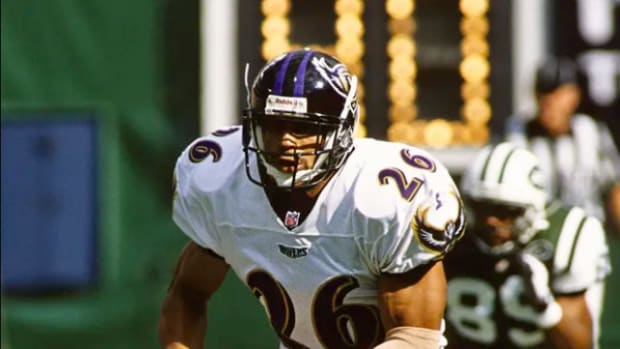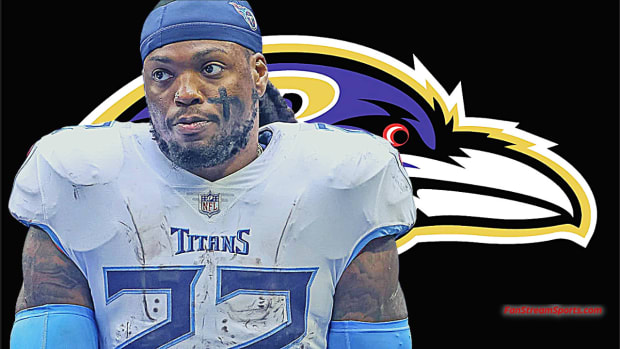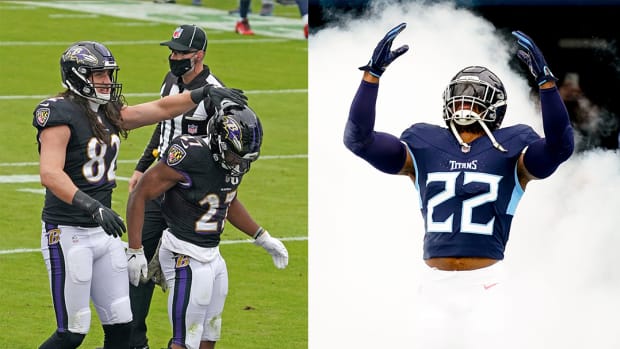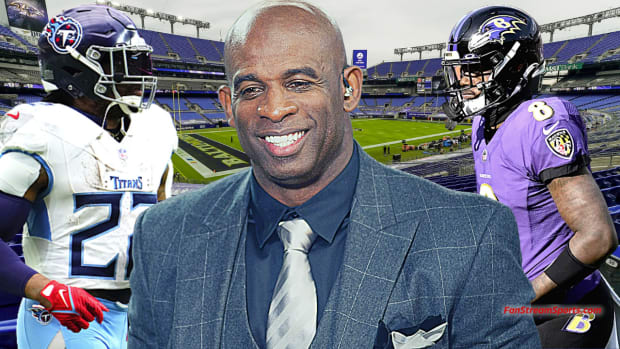How Coronavirus and Social Distancing Will Affect Teams During the NFL Draft
Here’s a story from three years ago, about a normal scene in the draft room. A quarterback was up on the screen, and the debate was healthy, robust and all over the place.
One scout in the room had him graded as worthy of the first overall pick, while others had first-round grades on him but weren’t quite that strong. Others still marked him as a second- or third-round pick. And no one was really pounding the table, until a coach, who’d seen limited tape on the kid, declared, “I f---ing love this guy.”
He then launched into an explanation of what was so good about the player on the screen, bringing up many of the things that have manifested themselves the last couple years.
“And as he’s describing what’s so good about the guy,” said one person who was in the room that day, “I’m thinking to myself, ‘I just learned something.’”
The team didn’t draft the player, but it was prepared to, because in those few minutes a consensus had started to build. Detractors were moved off their spots a little. Those who liked him started to like him more. The process was working.
The player? Patrick Mahomes.
This week, in a memo to every team, the NFL declared that the draft will go forward as scheduled, April 23–25. The event won’t be held in Las Vegas, and whether or not teams will be able to use their facilities is up in the air. And there are valid arguments on both sides of whether the NFL should be going forward with it at all.
But this much we pretty much know—scenes like the one described above, which are common across the NFL every April, won’t be happening this year. What you see on your television may not look much different from what you see every year, sans the massive street party. The experience for all these teams over the next month, though, will be.
And that means, as the NFL steamrolls forward, the results might be too.
***
We’re now entering the third full week of our strange new reality, and the NFL offseason is moving ahead. So the MMQB is going to with it. In this week’s column, we’ve got…
• A list of highly-regarded draft prospects who will be negatively affected by the crisis.
• Details on how veteran players are handling this new reality.
• More on a real-life heroic move from the NFL player ranks.
• Nuggets on the continuing carousel of free agency.
But we’re starting with the league’s decision to move forward with the NFL draft.
***
On Tuesday, the owners will hold a conference call to replace parts of their annual meeting, which was supposed to kick off yesterday but was canceled a couple weeks ago. And it’ll start with an update from the league’s chief medical officer, Dr. Allan Sills, and Dr. Dev Anderson, a professor at Duke who’s been the NFL’s point of contact at DICON (the Duke Infection Control Outreach Network).
Those are definitely different kinds of keynote speakers than the owners are used to hearing from this time of year, as these are definitely different times.
But those on Park Ave. have been leaning on them. Sills has been regularly leading calls among league officials the last few weeks and has been discussing criteria for re-opening team facilities and welcoming players back to work, since one of the first questions from, well, everyone has been what would prompt a return to business as usual. That won’t, however, be part of Tuesday’s discussion with the owners, for a pretty obvious reason.
The NFL, like the rest of us, has no idea when it’ll be time to put such a plan into motion.
That leaves the draft as the only thing on the 2020 ledger that the 32 teams can approach with any certainty. And while coaches, execs and scouts did not like how commissioner Roger Goodell threatened them with discipline for criticizing the NFL’s decision to go forward with the draft—“ridiculous and embarrassing” is what one AFC exec called the warning in last week’s memo—opinions are split on the actual call to keep the event where it is on the calendar, and everyone is moving forward as best they can.
Much will be different. Here are a few examples:
Draft meetings. Scenes like the one I described above are the one thing that came up consistently with the teams I spoke to. The ability for a general manager to advance a debate in the room by saying, “Let’s put on the tape and see,” is severely hindered, at best. And a lot of teams have these meetings with coaches and scouts all the same together, which allows for robust conversation and workshopping of disagreements like the Mahomes debate.
“Now, everyone will be there on video conference,” said one AFC GM. “We can’t sit in my draft room, me and my scouts, and watch Joe Burrow together. We may have some debate, and someone might say, ‘Hey, go watch this kid against Clemson and tell me he can’t do X or Y or Z. Or debate a guy, find a common opponent and settle it. Or with Senior Bowl guys, say, ‘Well, let’s watch them against same opponents’ and watch that right tackle against these two D-ends.
“It’s all going to have be independent film work, then discussing it.”
That, of course, is less efficient (though some believe it’ll make the opinions of scouts less biased), and may make it harder to get through as many guys as a team normally would with this sort of discussion. And that’s why teams are working through solutions, like projecting game tape into video conference, or having smaller breakout video conferences incorporating tape with individual area scouts and position coaches.
“We probably won’t do meetings as a, ‘Let’s watch these guys’ thing anymore,” said an AFC exec. “It’ll probably be more going to coaches and scouts and saying, ‘Watch these five guys, and come back and let’s talk about it.’”
The value of time on the road will rise. This is another thing that was unanimous: Teams that pound the pavement with good people in the fall will be rewarded. That means having high-level people (GMs, directors) out there in-season, and it also means having road scouts that have done the work and are reliable.
“More than any time since I’ve been a scout, we’re really going to be relying on our scouts,” said one NFC executive. “I mean, we’re really gonna be relying on them. They’ve had the interaction on the ground, they should know the kids.”
Another value in all that time on the road? The value of connections. When there’s a question on a prospect, now more than ever, having relationships with coaches and staff at different schools will be vital, so questions on character, injuries or overall ability can be answered honestly without someone needing to even start the car and go anywhere.
“That’s the other thing: I’ve spent more time on the phone than ever before in my career these last two weeks,” continued the exec. “You’re leaning on connections, your sources. You’d generally like to be in their office, maybe come up for 10 minutes after the workout. But if you’ve known a guy for 20 years, you may not need that face-to-face. And that’s what you’ll want, because normally 80% of it is face-to-face, 20% is over the phone. Now, it’ll be reversed, even more than that, where it’s 90% phone calls or FaceTime.”
Replacing the 30 visits. One team I talked to has had about 100 of the allowable draft calls—teams are permitted three per week with each prospect, with each call limited to an hour—via Zoom already. Another’s getting started tomorrow, but did dry runs last week. Soon, all will be conducting them because of the loss of what are commonly referred to as “30 visits,” the de facto job interviews that teams are allowed to fly up to 30 players in for.
The early returns? Well, a team can get a pretty good idea of a player’s mental aptitude and ability to learn over the technology. What’s harder is reading body language and presence. As one veteran scout said, “There’s an instinct you have ... you’re gonna miss that now.”
But the biggest thing lost is that teams, during those visits, are allowed to have kids meet with their doctors and trainers, and to put them through a physical to close their medical files. Not having the ability to do that—and we’ll get back to this—is an awfully big deal.
Building the board. This will affect some teams more than others—and it’s all based on the involvement of the staff. For a team like New England, where less than a handful of people actually see the board, the effect will be negligible. But other teams work in larger groups to get through close calls on players at certain positions.
That’s best done in draft meetings with everyone in one room, since you probably aren’t going to be sending your board around via email.
“When we’re building the board, we’re building it together,” said another NFC exec. “And a lot of thought goes into it. ‘Hey, what about this guy over this guy? Well, let’s see those two players covered by these players.’ And guys are looking at the board the whole time. It’s good to have fresh opinions, people challenging you on your opinion, because ultimately scouts are paid for opinions. It’s a huge part of the feedback for us. We want them to challenge us.”
Coaches' involvement. The Patriots, again, are a team that involves their coaches heavily in the draft, as are New England–connected teams like the Lions and Dolphins. The Bengals and Steelers are like that too, as are the Cardinals. Some teams that are aggressive in getting coaches involved earlier, at the Senior Bowl and the combine, will likely have more informed coaches now (the Rams and Broncos didn’t send theirs to Indy).
Here’s what’ll be common among all teams: Coaches’ work on prospects will be more affected than scouts’, mostly because coaches are at a much earlier stage of their process (having just jumped in, at the earliest, in January) than their personnel-side counterparts. That said—as is the case with all of these elements—teams are looking for, and some are finding, benefit in the change.
“Coaches might actually get to know players better because, honestly, they don’t have a ton to do,” said a third NFC exec, also referencing the likely cancellation of offseason programs. “There’s a whole lot more film coaches can through now since they’re not on the road or starting their offseason programs.”
“One of the hardest parts of business, this time of year, your coaches talk to buddies on other staffs on players that they haven’t watched, and they’re biased before they turn the film on,” said the AFC GM. “And most teams send their coaches to pro days. With less of that—because it’s easy to talk there, you’re around your friends in person—I do think we are going to get a truer feel for what coaches think.”
Medicals, medicals, medicals. This appears to be the biggest issue looming over everyone—and it’s especially big on players who either weren’t invited to the combine or are coming back from an injury. The annual combine recheck is usually a way to get updates. Without that, or 30 visits to tie up loose ends, teams are going to have to rely on information coming from the players, agents and others with a vested interest.
You’ve probably seen agent-generated videos on social media of prospects doing splits or box jumps or running 38-yard dashes (wink, wink) over the years. (Our Kalyn Kahler wrote about these Stupid Human Tricks last year.) Teams have always ignored those, and likely won’t put much more stock into them this year—even with agents already getting hyper-aggressive in sending them to GMs and coaches after their players had pro days canceled.
Medical information might be a little different, so long as it’s from a trusted place, like a doctor whom teams know, or the school itself. If the relationships are strong enough for a team to have its doctors and trainers call the doctors or school officials, even better.
“If you want to know how an ACL repair is going, you want your own doctors to put hands on him,” said the second NFC exec. “And we’re still working through that, to be honest, how to truly approach that. Maybe there’s enough information where your doctor can make his best estimate. And maybe if it’s a guy that has had multiple surgeries, you might shy away.”
That said, the idea of NFL teams having blind spots on players medically isn’t completely foreign either.
“We got the medical on all the combine players, which is good, and the select few rechecks we’d like to get, and medicals on the guys that didn’t go (to combine), those will be risks,” said a second AFC GM. “But I’ve talked to people in baseball, and they get no medical on guys coming in. Zero. We’ll have to rely on scouts and doctors. But there are a lot of guys you bring into your building you haven’t gotten hands on, especially undrafted guys
IT, IT, IT. So this part is weird, but relatable—team folks, through trial and error, are recognizing that home Wi-Fi and plugged-in, business-grade internet are two very, very different things. And the files that are being moved are massive. Streaming video, as one exec put it, “worked like a charm at the office, and then you get to your house, and it doesn’t work worth a damn.”
So team IT people are working to try to recreate what’s available in a football facility that’s had tens of millions of dollars of technology poured into in someone’s home office. Which doesn’t happen with someone snapping their fingers and making it so, no matter how much your high-speed connection at home may have you believing otherwise.
***
Then, there’s the draft itself. For now, teams are adjusting. One team I spoke with will have three guys running meetings from someone’s house starting this week, with others video-conferenced in as needed; others will be doing meetings completely remotely. Continuing like this when draft weekend gets here will be more difficult.
During the draft, teams may assign a handful of people to work the phones, with each responsible for trade calls with, say, 5–10 teams. The GM and the head coach will be there, of course, as well as a director of player personnel type, the college scouting director and the cap guy. The pro scouting director is needed too, to track other team’s needs, which are usually on a separate board that helps to project picks and set up trades.
That’s six people without even getting past the first person on the coaching staff or the first person on the scouting staff, and all of these people, in theory, would have to be working the phones in this skeleton scenario. The teams I talked to, for the most part, said they’d need 10-15 people on hand to do the draft efficiently and as normal.
If that’s not possible? It could have a tangible effect on how the draft goes. Teams will probably be more risk-averse to begin with, because of the holes (medical and otherwise) in scouting reports, and because there’ll almost certainly be less time to get players ready to contribute, with the probable loss of offseason programs. If you have a patchwork draft-day setup affecting communication, you could see the same sort of caution on the trade market.
“That’s the hardest part,” said the second NFC exec. “Having the draft the same weekend’s OK, everyone will adjust. We have all the same information, and teams that did their homework will get through it. But the hardest part is, that weekend, there’s so much communication with other teams, with your pro scouting staff, your college staff. What does this team need? Who’ll come up and get this guard or receiver?
“There’s constant communication, guys on the phone. If you’re not in the same room, that’s going to be really difficult. The GM can only do so much.”
Or instead of seeing a lot of teams moving around the board on draft weekend, you may just see them, as one executive predicted, try and trade for vets to plug holes before the draft, knowing it’s less likely this year that a rookie will be able to fill an immediate need, and knowing that the draft is going to be hard enough as is.
So yes, the draft will go on.
But the idea that it’ll be the same? The people who really know what it’s like aren’t pushing that one.





